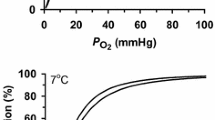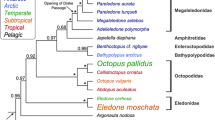Summary
The effect of pH, temperature, and l-lactate on the O2 bindign properties of haemocyanin (Hc) from three talitroidean species i.e., the aquatic Apohyale pugettensis, the semi-terrestrial Megalorchestia californiana, and the semi-/euterrestrial Traskorchestia traskiana was studied. The Hc of A. pugettensis was characterized by a higher O2 affinity (and more pronounced Bohr shift) than the Hc of either M. californiana or T. traskiana. Apohyale was the only species that possessed He that was sensitive to temperature change. Resuspending Hc from each of the three species in a stock Ringer's solution (based on the ionic composition of the haemolymph of T. traskiana) showed that the persistence of the difference in Bohr shift between Apohyale and the other two species was due to differences in the haemocyanins themselves and not attributable to their respective ionic environments. An inverse relationship was found between the cooperativity (n 50) and pH of Hc from T. traskiana and A. pugettensis but not for M. californiana. In each case adding l-lactate increased Hc O2 affinity, but this was most pronounced for A. pugettensis.
Similar content being viewed by others
Abbreviations
- Hc :
-
haemocyanin
- STR :
-
stock Traskorchestia Ringer's solution
References
Booth CE, McMahon BR, Pinder AW (1982) Oxygen uptake and the potentiating effects of increased haemolymph lactate on oxygen transport during exercise in the blue crab, Callinectes sapidus. J Comp Physiol 148: 111–121
Bridges CR, Morris S (1986) Modulation of haemocyanin oxygen affinity by l-lactate — a role for other cofactors. In: Linzen B (ed) Invertebrate oxygen carriers. Springer, Berlin Heidelberg New York, pp 341–352
Bridges CR, Morris S, Grieshaber MK (1984) Modulation of haemocyanin oxygen affinity in the intertidal prawn Palaemon elegans (Rathke). Respir Physiol 57: 189–200
Bousfield EL (1982) The amphipod superfamily Talitroidea in the north-eastern Pacific region. 1. Family Talitridae; systematics and distributional ecology. Publ Biol Oceanogr, Nat Mus Canada no. 11, 73 pp.
DcZwaan A, Putzer V (1985) Metabolic adaptations of intertidal invertebrates to environmental hypoxia (A comparison of environmental anoxia to exercise anoxia). Symp Soc Exp Biol 39: 33–62
Hurley DE (1968) Transition from water to land in amphipod crustaceans. Am Zool 8: 327–353
Ivlev VS, Suschenya LM (1961) Intensity of aquatic and atmospheric respiration in some marine Crustaceans. Zool Zh 40: 1345–1353
Johnson BA, Bonaventura C, Bonaventura J (1984) Allosteric modulation of Callinectes sapidus haemocyanin by binding of l-lactate. Biochemistry 23: 872–878
Mangum CP (1982) On the relationship between P 50 and the mode of gas exchange in tropical crustaceans. Pacif Sci 36: 403–410
Mangum CP (1983a) Oxygen transport in the blood. In: Bliss DE (ed) The biology of Crustacea, vol 5. Academic Press, New York London, pp 373–429
Mangum CP (1983b) On the distribution of lactate sensitivity among haemocyanins. Mar Biol Lett 4: 139–149
Marsden ID (1984) Effects of submersion on the oxygen consumption of the estuarine sandhopper Orchestia chiliensis. Mar Biol 59: 211–218
Marsden ID (1985) Some factors affecting survival and oxygen uptake in a subtropical beachflea. J Exp Mar Biol Ecol 88: 213–225
Moore PG, Taylor AC (1984) Gill area relationships in an ecological series of gammaridean amphipods (Crustacea). J Exp Mar Biol Ecol 74: 179–186
Morris S (1988) Effects of freezing on the function and association rate of crustacean haemocyanins. J Exp Biol 138: 535–539
Morris S, Greenaway P, McMahon BR (1988) Adaptations to a terrestrial existence by the robber crab Birgus latro. 1. An in vitro investigation of blood gas transport. J Exp Biol 140: 477–491
Morris S, Taylor AC, Bridges CR, Grieshaber MK (1985) Respiratory properties of the haemolymph of the intertidal prawn Palaemon elegans (Rathke). J Exp Zool 233: 175–186
Sevilla C, Lagarrique JG (1979) Oxygen binding characteristics of Oniscoidea haemocyanins (Crustacea; terrestrial isopods). Comp Biochem Physiol 64A: 531–536
Sick H, Gersonde K (1969) Method for continuous registration of O2 binding curves of haemoproteins by means of a diffusion chamber. Analyt Biochem 32: 362–376
Spicer JI, McMahon BR (1989) Aquatic gas exchange and transport in the long-horned sandhopper Megalorchestia californiana Brandt. Abstracts of the SEB Edinburgh meeting, A 19: 125
Spicer JI, Taylor AC (1986) A comparative study of the gill area relationships in some talitrid amphipods. J Nat Hist 20: 935–947
Spicer JI, Taylor AC (1987) Carbon dioxide transport and acidbase regulation in the blood of the beach-hopper Orchestia gammarellus (Pallas) (Crustacea: Amphipoda). Ophelia 28: 49–61
Spicer JI, Taylor AC (1989) O2-binding by the blood of the landhopper Arcitalitrus dorrieni (Hunt) (Crustacea: Amphipoda). comp Biochem Physiol 92A: 421–422
Spicer JI, Moore PG, Taylor AC (1987) The physiological ecology of land invasion by the Talitridae. Proc R Soc Lond 232B: 95–124
Spicer JI, Taylor AC, McMahon BR (in press) Haemocyanin oxygen binding in the sandhopper, Talitrus saltator (Montagu) (Crustacea: Amphipoda). J Exp Mar Biol Ecol 135: 213–228
Taylor AC, Spicer JI (1986) Oxygen transporting properties of the blood of two semi-terrestrial amphipods, Orchestia gammarellus (Pallas) and O. mediterranea (Costa). J Exp Mar Biol Ecol 97: 135–150
Truchot J-P (1971) Etude comparée de la fixation de l'oxygène par le sérum de cinq espèces de Crustacés Décapodes Brachyoures. C R hebd Séanc Acad Sci Paris (ser D) 212: 2706–2709
Truchot J-P (1980) Lactate increases the oxygen affinity of crab hemocyanin. J Exp Zool 214: 205–208
Young RE (1972) The physiological ecology of haemocyanin in some selected crabs. II. The characteristics of haemocyanin in relation to terrestrialness. J Exp Mar Biol Ecol 10: 193–206
Author information
Authors and Affiliations
Rights and permissions
About this article
Cite this article
Spicer, J.I., McMahon, B.R. Haemocyanin oxygen binding and the physiological ecology of a range of talitroidean amphipods (Crustacea) I. pH, temperature, and l-lactate sensitivity. J Comp Physiol B 160, 195–200 (1990). https://doi.org/10.1007/BF00300953
Accepted:
Issue Date:
DOI: https://doi.org/10.1007/BF00300953




